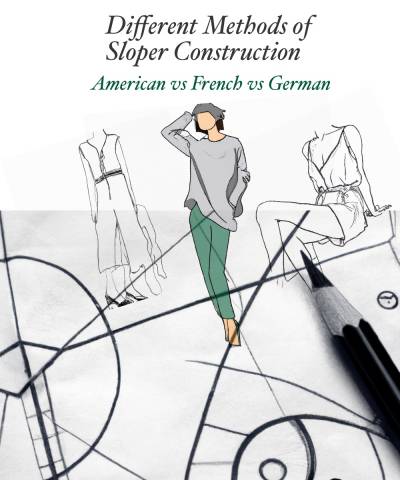The Difference Between the German, French and American Methods of Sloper Construction
Tips and tricks.
The Difference Between the German, French and American Methods of Sloper Construction
When it comes to sewing and pattern drafting, the American, German, and French approaches to creating slopers can indeed show some distinctive characteristics. Let's break down the key differences and highlight a few innovators associated with each method.

American Sloper
The American sloper method emphasizes practicality and simplicity. It usually involves taking precise measurements of the body and creating a basic template that fits closely to those measurements. The American approach is straightforward and aims to achieve a comfortable fit for everyday wear. One of the significant advantages is that it's relatively quick and easy to create.
American Method- Lower armhole.
- Different pant shape.
- Requires fewer girth alterations, but more length alterations.
Innovators: Helen Joseph-Armstrong is a prominent name in the world of pattern drafting. Her book "Patternmaking for Fashion Design" has been a staple in many fashion design courses and outlines American sloper techniques. Her contributions have helped aspiring designers and sewists grasp the fundamentals of pattern drafting.
German Sloper
The German method places a strong emphasis on precision and meticulous measurements. The focus is on achieving a tailored fit with minimal ease. German slopers are often characterized by their attention to small details, such as dart placements and angles. This approach is particularly useful when creating more structured garments.
German Method- Uses a lot of measurements.
- More precise and mathematical.
- Focuses on creating a perfect fit.
Innovators: Müller & Sohn is a renowned German pattern drafting system. Their work has influenced many pattern makers by providing comprehensive guides and tools for precise measurements and pattern manipulation. The attention to detail in their method has made it a favorite among those who seek a meticulous fit.
French Sloper
The French approach to slopers is known for its elegance and emphasis on draping. Instead of relying solely on measurements, the French method involves draping fabric on a dress form to create a three-dimensional pattern. This technique allows for a graceful fit and is often used in haute couture and high-fashion designs.
French Method
- More intuitive and artistic.
- Focuses on creating a beautiful garment.
- Uses draping to create the sloper.
Innovators: Madame Madeleine Vionnet is a legendary figure associated with the French method. Her innovative draping techniques revolutionized pattern drafting. Vionnet's creations showcased the beauty of bias-cut garments and how draping directly on the form could lead to exquisite silhouettes.
In summary, the choice between American, German, or French sloper methods depends on your personal preference and the type of garment you're creating. Each approach has its unique strengths and applications. Whether you're aiming for a practical everyday fit, a tailored precision, or an elegant haute couture design, understanding these different methods can greatly enhance your pattern drafting skills.
Some people may prefer a more precise and mathematical approach, while others may prefer a more intuitive and artistic approach. It's also important to keep in mind that creating a sloper can be a time-consuming process, but it's worth it to ensure agood fit for your finished garment.